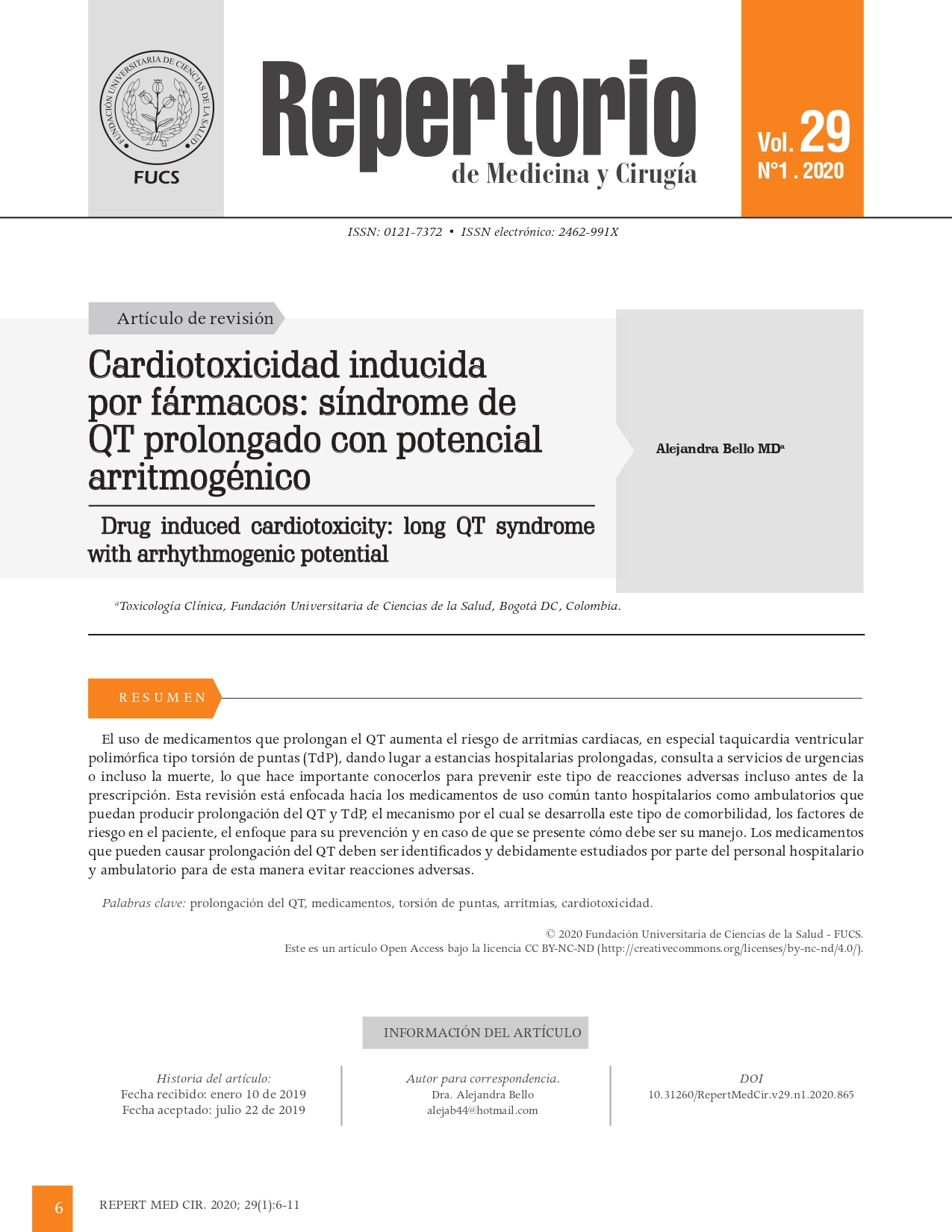Citaciones
Cardiotoxicidad inducida por fármacos: síndrome de QT prolongado con potencial arritmogénico
Drug induced cardiotoxicity: long QT syndrome with arrhythmogenic potential
Sección
Artículo de revisión
Cómo citar
Bello Benavides, L. A. (2020). Cardiotoxicidad inducida por fármacos: síndrome de QT prolongado con potencial arritmogénico. Revista Repertorio De Medicina Y Cirugía, 29(1). https://doi.org/10.31260/RepertMedCir.v29.n1.2020.865
Dimensions
Cómo citar
Bello Benavides, L. A. (2020). Cardiotoxicidad inducida por fármacos: síndrome de QT prolongado con potencial arritmogénico. Revista Repertorio De Medicina Y Cirugía, 29(1). https://doi.org/10.31260/RepertMedCir.v29.n1.2020.865
Descargar cita
Licencia
Esta obra está bajo una licencia internacional Creative Commons Atribución-NoComercial-CompartirIgual 4.0.
Mostrar biografía de los autores
##plugins.themes.bootstrap3.displayStats.noStats##
Visitas del artículo 1258 | Visitas PDF 2320
Descargas
Los datos de descarga todavía no están disponibles.
- Schwartz PJ, Woosley RL. Predicting the Unpredictable: Drug-Induced QT Prolongation and Torsades de Pointes. J Am Coll Cardiol. 2016;67(13):1639-50. doi: 10.1016/j.jacc.2015.12.063.
- Vlachos K, Georgopoulos S, Efremidis M, Sideris A, Letsas KP. An update on risk factors for drug-induced arrhythmias. Expert Rev Clin Pharmacol. 2016;9(1):117-27. doi: 10.1586/17512433.2016.1100073.
- Wisniowska B, Tylutki Z, Wyszogrodzka G, Polak S. Drug-drug interactions and QT prolongation as a commonly assessed cardiac effect - comprehensive overview of clinical trials. BMC Pharmacol Toxicol. 2016;17:12. doi: 10.1186/s40360-016-0053-1.
- Villamañán E, Armada E, Ruano M. Prolongación del intervalo QT inducido por fármacos: ¿conocemos sus riesgos? Medicina Clínica. 2015;144(6):269-74.
- Turker I, Ai T, Itoh H, Horie M. Drug-induced fatal arrhythmias: Acquired long QT and Brugada syndromes. Pharmacol Ther. 2017;176:48-59. doi: 10.1016/j.pharmthera.2017.05.001.
- Poluzzi E, Raschi E, Diemberger I, De Ponti F. Drug-Induced Arrhythmia: Bridging the Gap Between Pathophysiological Knowledge and Clinical Practice. Drug Saf. 2017;40(6):461-4. doi: 10.1007/s40264-017-0529-y.
- Lee A, Pickham D. Basic Cardiac Electrophysiology and Common Drug-induced Arrhythmias. Crit Care Nurs Clin North Am. 2016;28(3):357-71. doi: 10.1016/j.cnc.2016.04.007.
- Konstantopoulou A, Tsikrikas S, Asvestas D, Korantzopoulos P, Letsas KP. Mechanisms of drug-induced proarrhythmia in clinical practice. World J Cardiol. 2013;5(6):175-85. doi: 10.4330/wjc.v5.i6.175.
- Ng TM, Olsen KM, McCartan MA, Puumala SE, Speidel KM, Miller MA, et al. Drug-induced QTc-interval prolongation in the intensive care unit: incidence and predictors. Journal of pharmacy practice. 2010;23(1):19-24.
- doi: 10.1177/0897190009356549.
- Roden DM. Drug-induced prolongation of the QT interval. The New England journal of medicine. 2004;350(10):1013-22. doi: 10.1056/NEJMra032426.
- Drug and Therapeutics Bulletin. QT interval and drug therapy. BMJ. 2016;353:i2732. doi: 10.1136/bmj.i2732.
- Manini AF, Nair AP, Vedanthan R, Vlahov D, Hoffman RS. Validation of the Prognostic Utility of the Electrocardiogram for Acute Drug Overdose. Journal of the American Heart Association. 2017;6(2). doi:
- 1161/JAHA.116.004320.
- Hoogstraaten E, Rijkenberg S, van der Voort PH. Corrected QT-interval prolongation and variability in intensive care patients. Journal of critical care. 2014;29(5):835-9. doi: 10.1016/j.jcrc.2014.05.005.
- Ackerman MJ, Priori SG, Dubin AM, Kowey P, Linker NJ, Slotwiner D, et al. Beta-blocker therapy for long QT syndrome and catecholaminergic polymorphic ventricular tachycardia: Are all beta-blockers equivalent? Heart rhythm. 2017;14(1):e41-e4. doi: 10.1016/j.hrthm.2016.09.012.
- Passman R, Kadish A. Polymorphic ventricular tachycardia, long Q-T syndrome, and torsades de pointes. The Medical clinics of North America. 2001;85(2):321-41. doi: 10.1016/s0025-7125(05)70318-7.
- Kaufman ES. Mechanisms and clinical management of inherited channelopathies: long QT syndrome, Brugada syndrome, catecholaminergic polymorphic ventricular tachycardia, and short QT syndrome. Heart rhythm. 2009;6(8 Suppl):S51-5. doi: 10.1016/j.hrthm.2009.02.009.
- Khan IA. Long QT syndrome: diagnosis and management. American heart journal. 2002;143(1):7-14. doi: 10.1067/mhj.2002.120295.
- Gringut S. Short QT Syndrome. In: Ferri FF, editor. Ferri's Clinical Advisor 2018. Philadelphia: Elsevier; 2018. p. 1174-5.e1.
- Avci A, Yilmaz A, Celik M, Demir K, Keles F. Successful treatment of suicide attempt by megadose of propafenone and captopril. Cardiovascular toxicology. 2013;13(3):230-3.
- Ari ME, Ekici F. Brugada-Phenocopy Induced by Propafenone Overdose and Successful Treatment: A Case Report. Balkan medical journal. 2017;34(5):473-5. doi: 10.4274/balkanmedj.2016.1185.
- Bayes de Luna A, Brugada J, Baranchuk A, Borggrefe M, Breithardt G, Goldwasser D, et al. Current electrocardiographic criteria for diagnosis of Brugada pattern: a consensus report. Journal of electrocardiology. 2012;45(5):433-42.
- Thomas SH, Behr ER. Pharmacological treatment of acquired QT prolongation and torsades de pointes. British journal of clinical pharmacology. 2016;81(3):420-7. doi: 10.1111/bcp.12726.
- Pourmand A, Mazer-Amirshahi M, Chistov S, Sabha Y, Vukomanovic D, Almulhim M. Emergency department approach to QTc prolongation. The American journal of emergency medicine. 2017;35(12):1928-33.
- Tisdale JE. Drug-induced QT interval prolongation and torsades de pointes: Role of the pharmacist in risk assessment, prevention and management. Canadian pharmacists journal : CPJ = Revue des pharmaciens du Canada : RPC. 2016;149(3):139-52. doi: 10.1177/1715163516641136.













